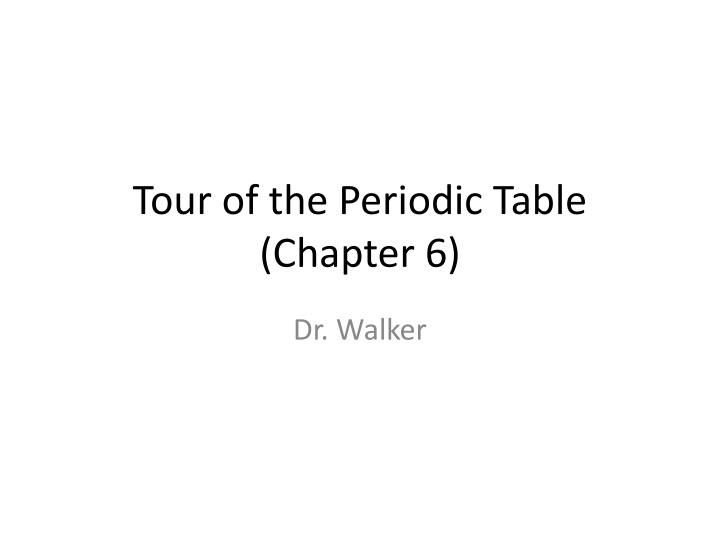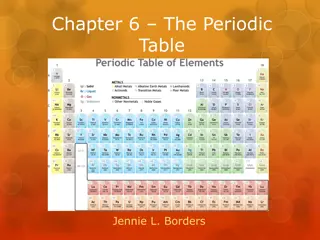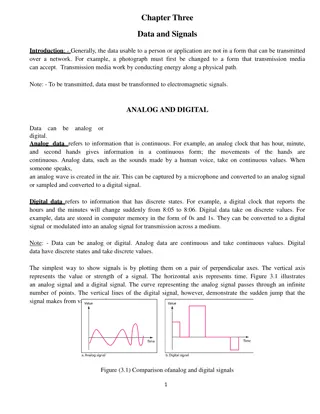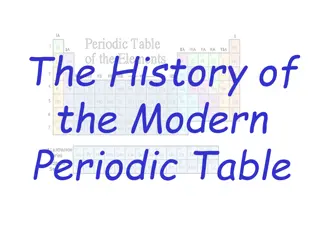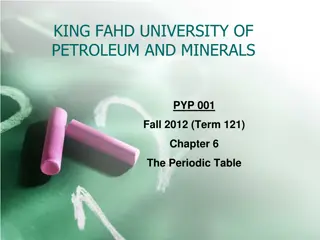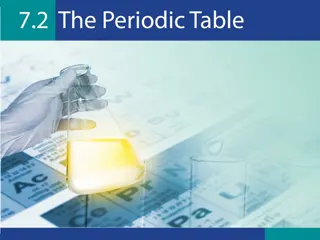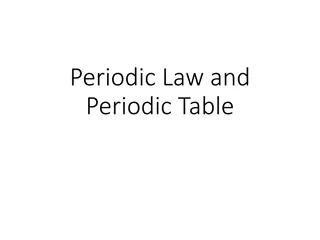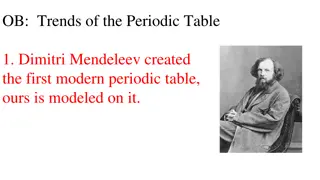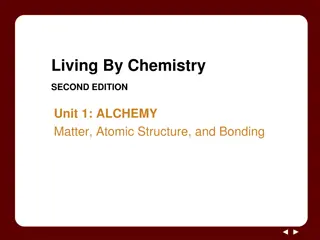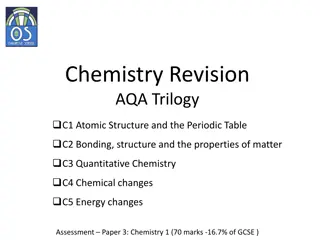Exploring the Periodic Table: Historical Development and Elemental Properties
Delve into the evolution of the periodic table from Mendeleev to Moseley, understanding how elements are arranged based on atomic number to reveal periodic trends. Learn about the significance of groups, diatomic elements, and valence electrons in defining the properties of elements.
Download Presentation

Please find below an Image/Link to download the presentation.
The content on the website is provided AS IS for your information and personal use only. It may not be sold, licensed, or shared on other websites without obtaining consent from the author.If you encounter any issues during the download, it is possible that the publisher has removed the file from their server.
You are allowed to download the files provided on this website for personal or commercial use, subject to the condition that they are used lawfully. All files are the property of their respective owners.
The content on the website is provided AS IS for your information and personal use only. It may not be sold, licensed, or shared on other websites without obtaining consent from the author.
E N D
Presentation Transcript
Tour of the Periodic Table (Chapter 6) Dr. Walker
Objectives Describe the historical development of the periodic table Name the groups of the periodic table and describe their properties List elements that are diatomic Differentiate elements based on periodic trends
History First periodic table created by Dmitri Mendeleev Arranged elements by increasing atomic mass, which caused mistakes Was incomplete, but pattern predicted existence of elements found later Current periodic table created by Henry Moseley Arranged by increasing atomic number
The columns are called groups or families. Groups have similar physical and chemical properties.
Periodic Law When elements are arranged in order of increasing atomic numbers, their physical and chemical properties show a periodic pattern. Elements in the same groups have the same general physical and chemical properties because of their similar number of valence electrons. Periodicity is regularly repeating patterns or trends in the chemical and physical properties of the elements arranged in the periodic table.
More About Periodic Law Valence Electrons Electrons in the outer shell of an atom Determines chemical properties
Determining Valence Electrons How do we determine valence electrons? Valence electrons = last number of group number Examples Sodium Group 1 = 1 valence electron Boron Group 13 = 3 valence electrons Chlorine Group 17 = 7 valence electrons Nitrogen Group 15 = 5 valence electrons
Determining Valence Electrons We can also get valence electrons from the electron configuration Superscripts for highest energy level are valence electrons Includes s AND p electrons Examples Sodium 1s22s22p63s1 = 1 valence electron There is one electron in the third energy level Boron 1s22s22p1 = 3 valence electrons There are three electrons in the second energy level Chlorine 1s22s22p63s23p5 = 7 valence electrons There are seven electrons in the third energy level
Determining Groups Each group has a distinctive electron configuration ns2np2 = 4 valence electrons = Group 14 1s22s22p2 = carbon 1s22s22p6 3s23p2 = silicon 1s22s22p63s23p6 4s23d104p2= germanium
Determining Valence Electrons What about the transition metals (groups 3-12), actinides, and lathanides? We don t worry about these elements These elements can use electrons from d and f orbitals, which we won t deal with
Groups of the Periodic Table Group 1-Alkali Metals Physical Properties Soft Low melting points Low densities Chemical Properties Explodes in water Tarnish rapidly in air
Groups of the Periodic Table Group 2 - Alkaline Earth Metals Physical Properties Soft Chemical Properties React well with hot water Strong reducing agents
Groups of the Periodic Table Groups 3-12 - Transition Metals Physical Properties High density High melting point Magnetic
Groups of the Periodic Table Metalloids Diagonal Elements beginning with Boron B, Si, Ge, As, Sb, and Te Physical Properties Semi-conductors Chemical Properties Act like metals when they react with non-metals Act like non-metals when they react with metals
Groups of the Periodic Table Group 17 Halogens Physical Properties increase in density as you go down the column colored (yellow-green to brown to black) Chemical Properties Form salts with elements from alkaline metals Exist as diatomic molecules Form acids with hydrogen
Groups of the Periodic Table Group 18 - Noble Gases Physical Properties Colorless Odorless Tasteless Chemical Properties chemically inert (do not react) full valence shell
Hydrogen Why is this separate? Since it only has one electron, it is placed with group 1 Doesn t possess any chemical similarities with alkali metals Physical Properties Colorless, Tasteless, Odorless Chemical Properties Inflammable Highly reactive Exists as diatomic molecule
Diatomic Molecules Some elements exist as diatomic molecules Exists as TWO atoms covalently bonded to each other Mostly top right of periodic table H2, N2, F2, O2, I2, Cl2, Br2 ClIF H BrON
Not in guided notes! Inner Transition Metals Otherwise known as lanthanide and actinide series or f-block elements Some not found in nature (primarily actinides)
The rows are called periods. The period number matches the principle energy level of the element.
Periodic Trends Atomic Radius: Measure of the distance between radii of two identical atoms of an element. Ionization Energy: The energy required to remove an electron from an atom in its gaseous state Electronegativity: Measure of the attraction of an atom for electrons in a bond.
Atomic Radius Across periods: Radius size decreases due to increased nuclear charge Down a group: Radius size increases to due higher number of occupied shells
Ionization Energy The energy required to remove an electron from an atom in its gaseous state
Electronegativity Electronegativity: The tendency of an atom to attract electrons to itself when chemically combined with another element. The halogen group has the highest electronegativity of the families. The first period has the highest electronegativity.
Question If electronegativity increases to the right, why don t the noble gases have the highest electronegativity?
Question If electronegativity increases to the right, why don t the noble gases have the highest electronegativity? Electronegativity involves atoms in a bond. Noble gases DO NOT BOND! Therefore, no electronegativity value
Nuclear Shielding Outer shell electrons feel less effect of the positive nucleus because of the inner shell electrons. The nuclear shielding effect is constant within a given period and increases within given groups from top to bottom.
Shielding Trends Shielding is equal among elements in the same period
Chemical Reactivity Reactivity refers to how likely or vigorously an atom is to react with other substances. Metals and nonmetals have their own trends (can t be easy .can it?) Not in textbook, but on SOL (figures!) From http://www.pleasval.k12.ia.us/highschool/teachers/hoffmanjoshua/Chem%20PDF/Chem%20Unit%203/PeriodicTrendsReading.pdf
Chemical Reactivity - Metals Increases as you go down As you go down valence electrons are further from the nucleus Further from the nucleus, easier to get rid of Decreases left to right Further to the right, more electrons to get rid of Takes more energy to do this Not in textbook, but on SOL (figures!) http://edtech2.boisestate.edu/lindabennett1/502/Periodic%20Table%20e%20config/PTable_trends%20around%20table.html
Chemical Reactivity - Nonmetals Decreases as you go down Higher elements have more electronegativity The more they hog electrons, the faster they react Increases left to right The closer you are to filling an octet the more reactive it is Noble gases don t count their octet is full, so they don t react
Chemical Reactivity https://jahschem.wikispaces.com/file/view/Reactivity_Trends.jpg/211822562/Reactivity_Trends.jpg
Review What group is chemically unreactive? What is the Periodic Law? Give three diatomic elements. What group consists of elements that explode in water?
Review What group is chemically unreactive? Noble gases What is the Periodic Law? When elements are arranged in order of increasing atomic numbers, their physical and chemical properties show a periodic pattern. Give three diatomic elements. H2, N2, F2, O2, I2, Cl2, Br2 What group consists of elements that explode in water? Alkali Metals
Review Of F, B, and O, which is the most electronegative element? Of F, B, and O, which element has the largest radius? Of Rb, Na, and K, which element has the largest shielding effect?
Review Of F, B, and O, which is the most electronegative element? Fluorine (farthest right) Of F, B, and O, which element has the largest radius? Boron (farthest left) Of Rb, Na, and K, which element has the largest shielding effect? Rubidium (lowest on periodic table)
Terms to Know Mendeleev (name) Moseley (name) Valence electrons Alkali metals Alkaline earth metals Transition metals Metalloids Halogens Noble gases Inner Transition Metals Diatomic elements Atomic Radius Electronegativity Ionization Energy Nuclear Shielding
Skills To Master Determining diatomic elements Determining valence electrons from their position on the periodic table, by group name, and by electron configuration Classifying elements by their group name Arranging elements according to their periodic trends Electronegativity Atomic Radius Shielding Reactivity
